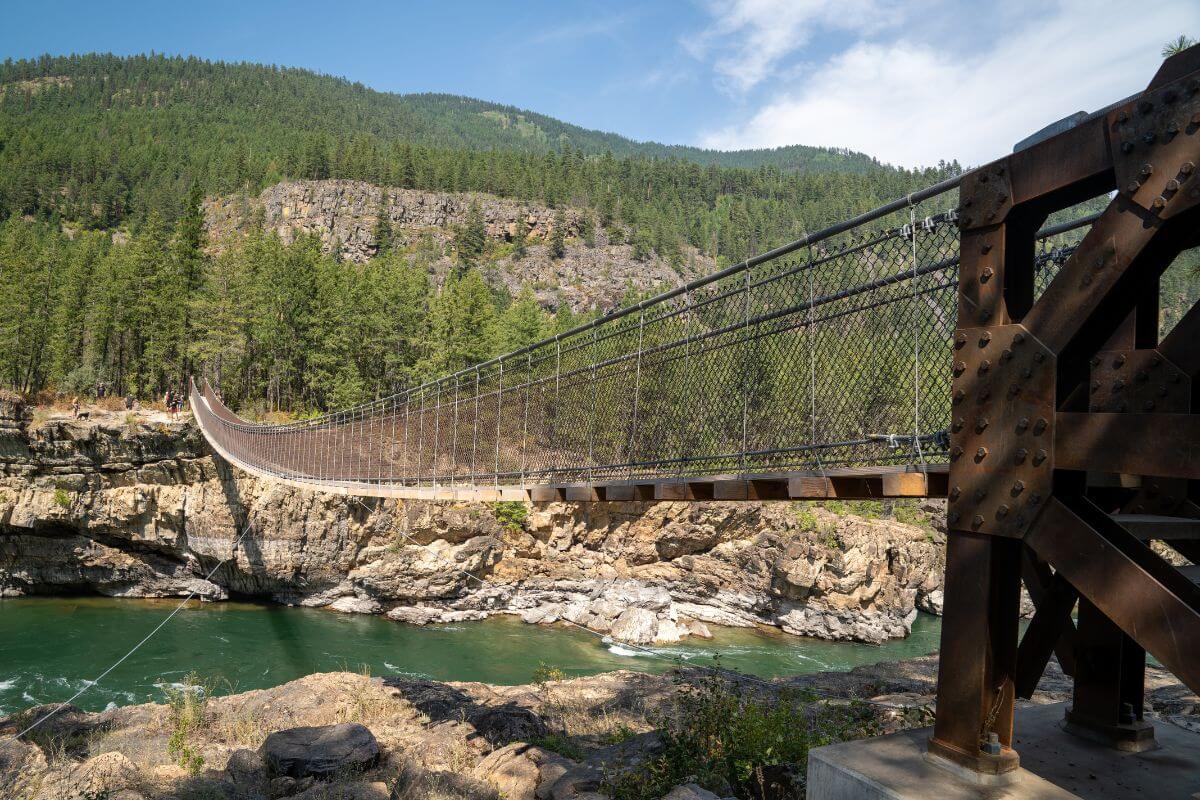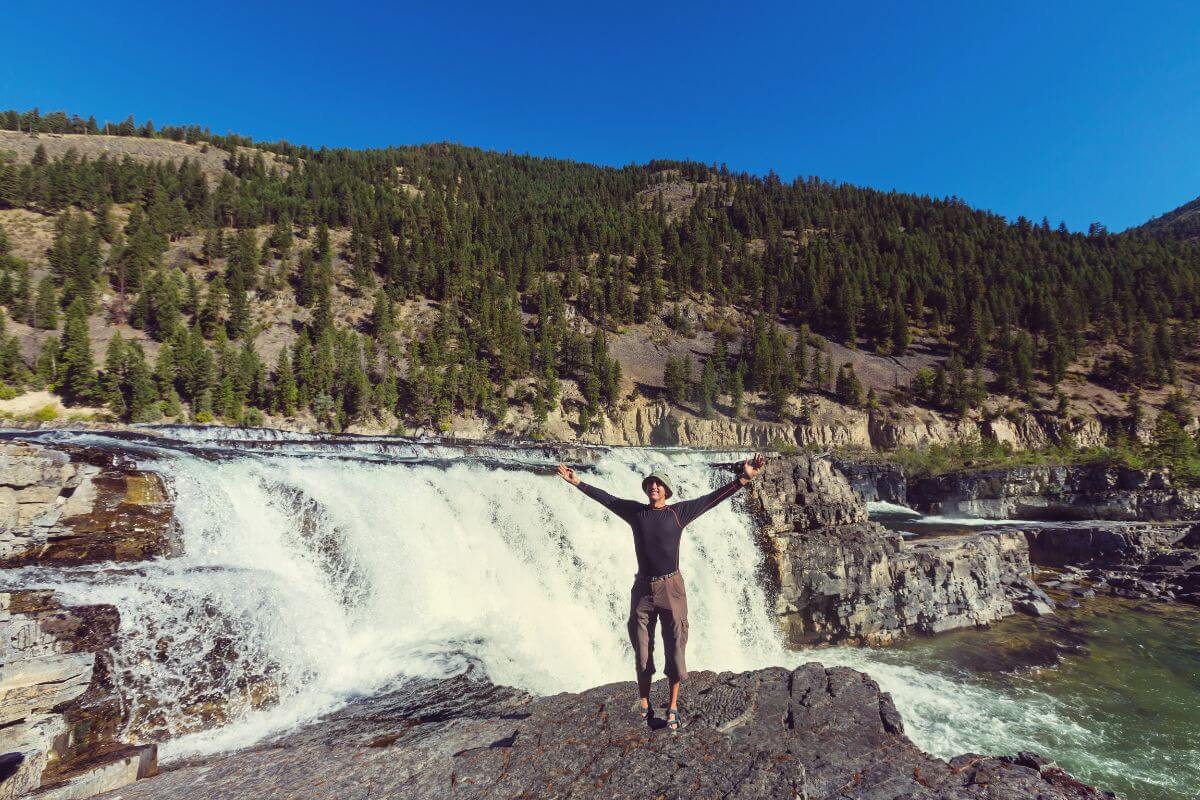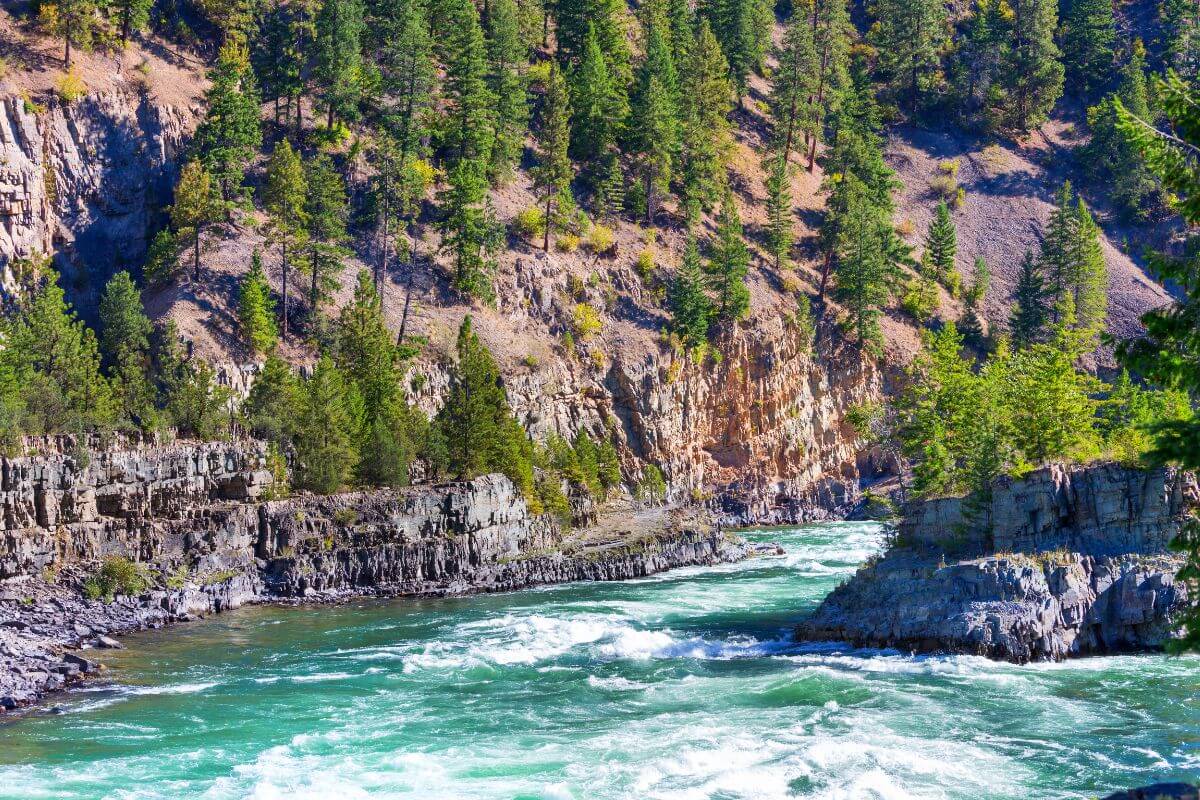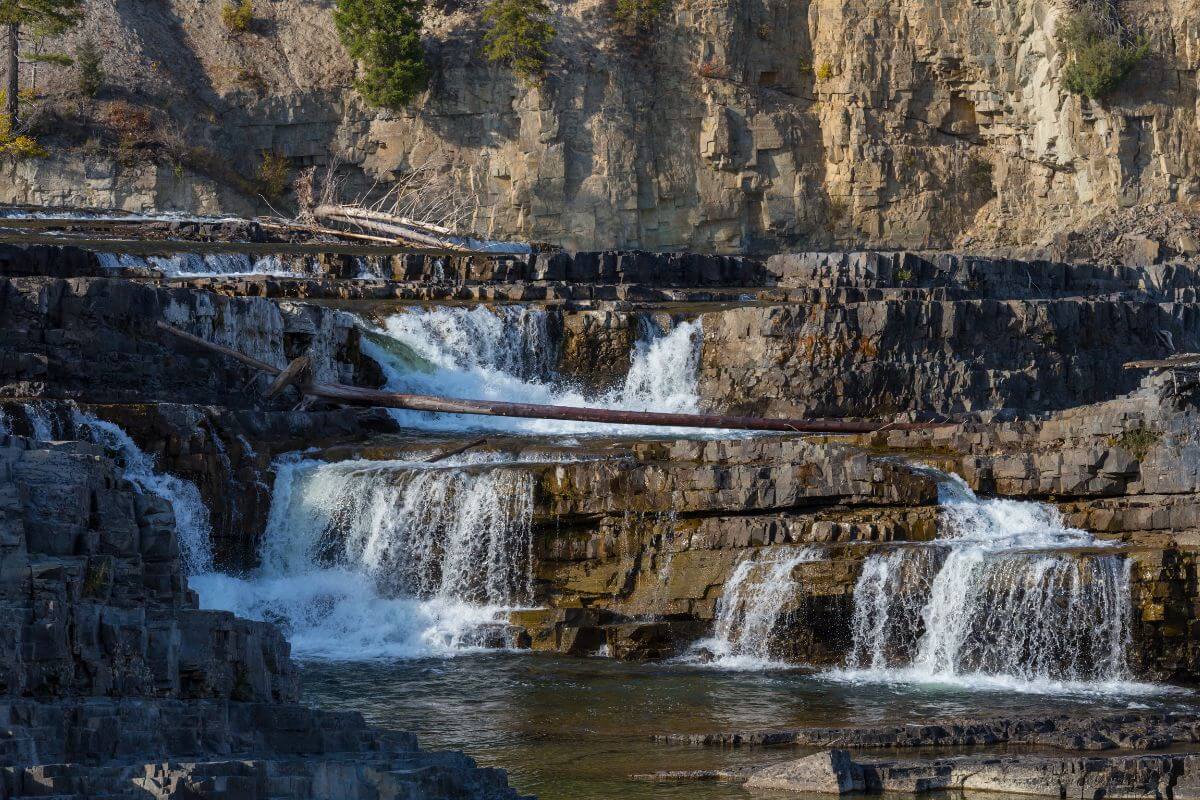Montana’s Kootenai Falls is a natural wonder that captivates with its beauty and power. As the largest undammed waterfall in the state and the Pacific Northwest, it holds a special place in the hearts of all who visit. The falls are a breathtaking sight, especially in late spring when nature’s forces are at their most impressive.
I’ll guide you through the experience of visiting Kootenai Falls, including the nearby swinging bridge that offers a unique perspective on the falls and the river. We’ll share tips for the best times to visit, tips when visiting, and fun facts about the falls.
- Related article: Waterfall Destinations in the Treasure State
Kootenai Falls not only provides an incredible view but also a chance to learn about the area’s history and cultural significance. Let’s dive into what makes this place so unique and why it’s a must-visit for anyone who loves the outdoors.
7 Key Takeaways on Kootenai Falls
- The trail to Kootenai Falls and its Swinging Bridge is a 1.6-mile (2.5 km) round trip with just 150 feet (45.7 meters) of elevation gain, offering an easy and accessible hike for most.
- The falls are located near Milepost 21 on US Highway 2, about 7 miles (11.2 miles) east of Troy and 12 miles (19.3 km) west of Libby, Montana, making it a convenient stop for those traveling through the area.
- The best time to visit is late May through mid-June when the falls are most impressive, with the water flowing powerfully.
- Kootenai Falls is the largest undammed waterfall in Montana and the Pacific Northwest, with significant historical and cultural importance to the Kootenai Tribe.
- The swinging bridge at Kootenai Falls offers a unique vantage point, standing 210 feet (64 meters) wide and 100 feet (30.4 meters) above the water, and is historically significant.
- The area is not just a scenic spot but also a place of deep historical significance, with Hollywood also recognizing its beauty in several films.
- Visitors are encouraged to be respectful of the wildlife and the natural environment, ensuring a safe and enjoyable experience for all at Kootenai Falls.
About Kootenai Falls
| Location Coordinates | Height | Nearby Features | Location |
|---|---|---|---|
| 48.45334° N, -115.76881° W | 90 feet (27.4 meters) | Cabinet Mountains Wilderness, Ten Lakes Scenic Area, and the Stone Hill Rock Climbing Area | Lincoln County, Montana, near the town of Libby |
The trail to Kootenai Falls and its Swinging Bridge is a delightful adventure with an elevation gain of just 150 feet (45.72 meters), making it an easy and accessible hike for most. The roundtrip distance to the falls and the bridge is 1.6 miles (2.5 km), offering a nice balance of challenge and enjoyment.
To reach the trailhead, head to US Highway 2, specifically 7 miles (11.2 miles) east of Troy and 12 miles (19.3 km) west of Libby, Montana. Look for the Kootenai Historical Marker at the 21-milepost.
The trail itself is a mix of dirt paths with some rocky and rubbly sections. At the beginning, there’s a short asphalt paved walkway leading to the overlook, which might be a bit challenging for some wheelchairs. The dirt trail also features a pedestrian bridge over the railroad tracks, with 64 steps leading down to the bridge.
The Swinging Bridge is a unique experience, offering a gentle side-to-side motion that adds to the thrill. Don’t worry, though; it’s designed to be strong and safe. The first pedestrian bridge you’ll encounter takes you over the BNSF railroad tracks, providing a taste of what’s to come.
The falls themselves are about a quarter-mile upstream, accessible via an easy but rocky trail. Along the way, you’ll find pit toilets for a quick rest stop, just a minute’s walk from the parking area. This makes it convenient to take care of any needs before or after your hike.
At the trailhead, you’ll find a large parking lot that can accommodate campers and RVs, making it a great spot for a longer stay. From May through September, there’s a small cafe concession service available, perfect for grabbing a snack or a drink. Picnic tables in the area make it an ideal place to enjoy some time in nature.
For the best experience, consider hiking in late May through June when the waterfalls are at their most impressive. This is when the melting snow and spring rains combine to create a truly breathtaking display of nature’s power and beauty.
About the Kootenai Swinging Bridge

The Kootenai Falls swinging bridge is a special spot that lets you uniquely experience Montana’s beauty. Originally, it was used by the Forest Service to reach forest fires on the other side of the Kootenai River.
The bridge’s story includes a flood in 1948 that washed it away, leading to its reconstruction on sturdy concrete piers, now shielded by the Libby Dam.
This bridge isn’t just a way to cross the river; it’s a destination in itself. It offers a breathtaking view of the Kootenai River gorge, standing 210 feet (64 meters) wide and 100 feet (30.4 meters) above the water. You can feel safe on it too, thanks to its strong cables.
Visitors are welcome to take in the stunning views from the bridge and then explore the trails nearby. These trails lead to the impressive Kootenai Falls and offer a chance to soak in the natural beauty around. It’s a great place for a leisurely walk and to appreciate the wonders of Montana’s outdoors.
Insider Tips for Visitors

Consider these insider tips to enhance your visit to Kootenai Falls:
- Optimal Time to Visit – Late May through mid-June is the optimal time to visit Kootenai Falls to witness the most impressive amount of water at the falls. However, the area is worth exploring anytime if you’re nearby and seeking a memorable outdoor experience.
- Picnic Considerations – Consider bringing a picnic to enjoy near the falls for an extended visit. The serene surroundings make for a perfect spot to relax and savor a meal amidst nature’s beauty.
- Safety Precautions – Safety precautions are essential when visiting Kootenai Falls, particularly concerning the powerful river. Maintain a safe distance from the water’s edge and exercise caution, especially when exploring with families or children.
- Wildlife Awareness – Be mindful of the presence of wildlife in the area, including bighorn sheep, elk, and black bears. To ensure your safety and the animal’s well-being, maintain a safe distance and refrain from approaching or feeding them.
Enjoy your time at Kootenai Falls, and make sure to take in all the beauty and power of nature while staying safe and respectful.
Interesting Facts About Kootenai Falls

Go on a journey through the captivating history and natural wonders of Kootenai Falls, where each fact reveals the awe-inspiring beauty and cultural significance of this iconic Montana landmark.
- A Natural Wonder – Kootenai Falls holds the distinction of being the largest undammed waterfall in Montana and the Pacific Northwest, and one of the largest in the United States by flow rate. Witnessing the thundering water firsthand is an awe-inspiring experience that leaves visitors mesmerized by its natural beauty and power.
- Hollywood Film Location – The iconic Kootenai Falls has served as a backdrop for four Hollywood movie shoots, including notable films like “The River Wild” and “The Revenant.” Its stunning scenery and rugged landscape have attracted filmmakers seeking dramatic settings for their productions.
- Swinging Bridge Experience – The Kootenai Falls swinging bridge, initially constructed for Forest Service firefighting efforts, has been rebuilt twice to enhance safety for visitors. This iconic bridge provides an exhilarating vantage point to admire the falls up close while offering a thrilling experience for adventure-seekers.
- Cultural Heritage – Kootenai Falls holds profound historical and cultural significance to the Kootenai Tribe. As a sacred site, visitors are urged to respect and preserve the area’s cultural heritage while enjoying its natural splendor.
- Spectacular Plunge – The Kootenai River, known for its relative peacefulness before the China Rapids, plunges over 90 feet (27.4 meters) in less than a mile to form the majestic Kootenai Falls.
- Historical Significance – The area around Kootenai Falls holds rich historical significance, with Canadian explorer David Thompson visiting the area in the 1800s. Thompson utilized trails and cairns established by the Kootenai Tribe, leaving behind a legacy that underscores the deep connection between humans and the natural environment.
Kootenai Waterfalls Final Thoughts

Kootenai Falls stands as a testament to the awe-inspiring beauty of nature, boasting the title of Montana’s largest undammed waterfall. Beyond its majestic cascade, the historic swinging bridge adds a layer of historical significance, offering visitors impressive views and a glimpse into the area’s past.
What makes Kootenai Falls truly remarkable is its accessibility, with trails suitable for adventurers of all ages and abilities. For the most spectacular experience, late May through mid-June is recommended, when the waterfall is at its most powerful and the surroundings are vibrant.
However, safety precautions must be observed, particularly around the powerful river currents and wildlife. Respecting the natural environment ensures a safe and enjoyable visit for all.
Kootenai Falls offers a blend of natural splendor and historical significance, providing visitors with a multifaceted experience. If you enjoy picnicking near the falls, crossing the swinging bridge, or simply marveling at the breathtaking views, there’s something for everyone to enjoy at this iconic Montana destination.
Kootenai Waterfalls FAQs
1. How Do I Get to Kootenai Falls?
Accessing Kootenai Falls is convenient via US Highway 2, with the trailhead located 6 miles east of Troy and 12 miles west of Libby, Montana. Look for the Kootenai Historical Marker at the 21-milepost.
2. Is the Trail Suitable for All Ages and Abilities?
Yes, the trail to Kootenai Falls is rated as easy and accessible to adventurers of all ages and abilities, including families with children and individuals with mobility challenges.
3. When Is the Best Time to Visit Kootenai Falls?
Late May through mid-June is recommended for witnessing the most spectacular waterfall display. However, the area is worth exploring year-round, offering different scenic experiences in each season.
Fascinated by the charm of Big Sky Country? Immerse yourself in the heart of Montana with these captivating articles:

